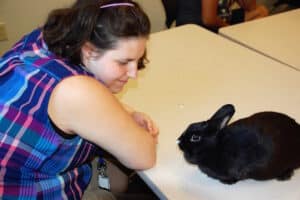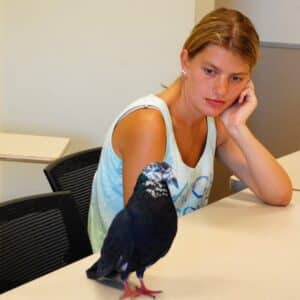
On Tuesday, Bryan Cushing learned the true meaning of “it’s a dog’s life.”
During “Animal Science,” one of the rigorous college-level courses high schoolers study in the Summer for Success program, Cushing, an instructor in the anthropology program at Beacon College who is teaching the course, was asked to leave the room.
The Animal Science class Cushing teaches allows students to explore careers with animals, learn how to care for animals, and sample different types of science used in animal facilities. Today’s lesson: introducing a fundamental of animal training, stationing — conditioning the animal to go to or stay put on a specific spot.
Unbeknownst to Cushing, however, Dr. Brian Ogle, Beacon’s lead anthrozoology instructor, intended to use Cushing as a guinea pig in a lesson in animal conditioning. That process, as Encyclopedia Britannica describes, involves “a response [that] becomes more frequent or more predictable in a given environment as a result of reinforcement, with reinforcement typically being a stimulus or reward for a desired response.”
Ogle told students to treat Cushing like a human-sized Snoopy. Their goal: make him sit.
A result they would need accomplish without uttering a word.

With the ground rules in place, Ogle summoned his colleague. Cushing entered the classroom.
Dead. .. Awkward. … Silence.
Then, bemused snorts of laughter all around.
Confused, Cushing surveyed the room, searching student faces for clues, before striding, unsure, forward.
Click! Click! Click!
He again searched the faces of the clicking students and then stopped in the center of room.
Click! Click! Click!
In that instant, for Cushing, it clicked.
He sat.
CLICK! CLICK! CLICK!
Good boy, er, professor.
“That was really easy,” Ogle said. “As you start building complex behaviors you start with what the animal knows and work your way up.”
Ogle played trainer.

Ogle’s goal: get the bird to roost on a slip of green paper on a desk.
Ogle opened the bird’s cage. Free, Maleficent seemed more interested in exploring the world than perching on parchment.
There is a “timeline of training,” Ogle explained. “Just like us, every animal learns differently.”
To sweeten the deal, he served up sunflower seeds on the paper.
Maleficent munched the bait, then swiveled its head to look at Ogle.
“He’s looking at the seed and me. What’s he looking for?”
“Further direction,” Ogle answered.
So he provided it.
“Station,” he said.
“Station.”
When the bird complied, Ogle provided seed and sounded a click.
In that way, the association of the seed with roosting on green paper eventually sticks.
Ogle repeated the process with a new subject, Ping, a male rabbit. He proved a less enthusiastic student.
Consequently, for a lesson in target training — that required the animal to touch its nose to the ball at the end of a wand — Ogle turned to his “target training powerhouse,” a two-year-old guinea pig named Anna.
Anna lived up to the billing, showing her nose knows, multiple times.
“Good girl,” Ogle praised.
Having finished putting Anna through her paces, Ogle posed a final query:
“Any questions?
Just one, from a chorus of students:
“Can we pet her?”